One of the most difficult challenges runners face is avoiding injuries.
Training, improving, and enjoying running would be infinitely easier if we didn’t have to worry about getting injured.
Unfortunately, the reality is that injuries do happen…and they happen often. Recent research estimates that 82 percent of runners will get injured at some point in their running career.
Luckily, you can take steps to reduce your chances of becoming a part of this statistic.
Running injuries occur primarily for two reasons – structural deficiencies and training issues.
Training mistakes that lead to injury include running too fast, too soon and increasing mileage too quickly. While I could easily write a book on these training mistakes, they’ve been covered extensively before.
Instead, in this 3-part series, I am going to focus on how you can build a strong structural system to stay injury-free.
In this article, we’ll focus on the “core” – abdominals, lower back, and pelvis.
I’ll begin by addressing the function of these areas, discuss how they’re affected by running, and show you a few of the most effective exercises to strengthen these areas to prevent injury.
How the core contributes to running
“Core” is a big buzzword these days, and as such, it’s bolstering an industry of bosu balls, wobble boards, and ab rollers. But, how do we define “core” and what does it actually mean for runners.
Ask to see a core workout from a personal trainer at a health club, and he’ll probably give you a series of crunches, planks, and sit-ups.
But “core” means something very different to a runner: it means all of the muscles of the lower trunk and pelvis; not just your abs and your back, but your hip flexors, abductors, and adductors too.
Let’s look at some of the most important areas of the core and how they impact your running:
Lower back: Transverse abdomins, erector spinae
The transverse abdominis, or TVA for short, is a thin cylindrical muscle that lies underneath the abdominals. The TVA is responsible for stabilizing the spinal column and reducing lower back, hip and groin injuries.
Simply speaking, a strong and healthy transverse abdominis helps the muscles prepare for movement and brace for impact by stabilizing the muscles, which results in a significant decrease in injury risk.
The erector spinae is a group of muscles on the back that helps the body lean forward and back.
A forward lean when running places extra stress on the erector spinae muscles in the lower back, which causes them to fatigue and predisposes you to having bad form.
Strengthening the erector spinae muscles can help prevent excessive leaning at the waist towards the end of a race,
Abdominals: rectus abdominis
The abs, despite being the most well-known muscle group of the “core”, are perhaps the least important when it comes to injury-free running.
Sure, they make you look great at the beach, but most research studies have shown they have little actual impact on running injuries.
As such, you don’t need to go out of your way to avoid targeting the abs, but most exercises (like crunches) aimed solely at strengthening the abs are likely a waste of time.
Hips: Adductors, abductors gluteal and iliopsoas
The group of muscles that make up what we call the hips (adductor, abductor, gluteal and iliopsoas) are particularly important because they’ve been implicated in a range of running injuries.
Weak hips can often be the cause of IT band pain, patella tendonitis (runner’s knee), piriformis issues, sciatica, and a myriad of other common running injuries.
In fact, the research on how close the connection is between hip weakness and running injuries is overwhelming.
One study conducted by Niemuth et al found that injured runners had weaker hip flexors and hip abductors on their injured side compared to their healthy side. Another more specific study by Ireland et al. found similar results: injured runners had weaker hip abductors as well as weaker hip external rotators on their injured leg.
An older study with a more innovative approach was conducted by researchers at Stanford University. In this study, injured runners who had all been diagnosed with iliotibial band (IT band) syndrome were assigned a six-week gluteus medius strengthening program (the gluteus medius is the main hip abductor and external rotator). After the six-week protocol, all but two of the injured runners were able to return to training healthy.
How to strengthen these areas to prevent injury
Now that we know just how important the “core” is to staying injury-free while training, how do you target it?
The goal of an effective core routine for runners is one that avoids over-targeting or isolating less effective muscle groups (like the abs) and puts more emphasize on the hips glutes, and transverse abdominis.
Here is a quick, very effective routine I recommend runners implement to get started building a better foundation:
Prone or plank with bent knee
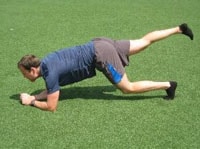
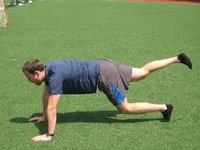
Muscle groups emphasized: Erector spinae, rectus abdominis (abs), and transverse abdominus and hip flexor.
Value for runners: This modification of the basic plank engages your hip flexor to place you in a more running specific position while still providing the same benefits as the basic plank.
Logistics: Hold the this bent leg position for up to 60 seconds.
Instructions: Flex your deep core muscles to prevent your lower back from sagging down or from angling up. You should be able to rest a board flat on your back, glutes, and legs. Beginners can balance their weight on their hands until they feel comfortable moving to the elbows (figure 2).
Clams
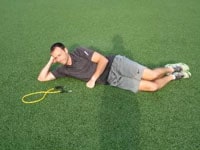
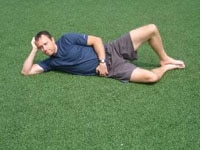
Muscle groups emphasized: gluteus medius
Value for runners: This exercise improves the control and function of the gluteus medius, a muscle found to be weak in distance runners with IT band issues. By working it in this way, the balance between the anterior and posterior hip muscles will be restored. It is not OK to substitute this exercise for the multi hip machine at the gym!
Instructions: Keep the pelvis perpendicular to the floor rather than rolling backwards, which is a way to cheat this exercise. Hold for 10 seconds at the top; work up to 20 repetitions.
Hip Thrusts
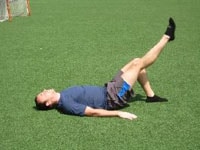
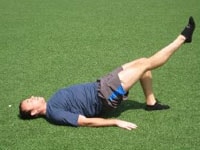
Muscle groups emphasized: Hips, glutes, lower back, and hamstrings.
Value for runners: This exercise dynamically targets the hamstrings, glutes, lower back, and hips (the posterior chain) to help prevent injury when introducing speed work into your training plan.
Logistics: Perform 15-25 repetitions each leg.
Instructions: At the top of the movement your body should be in a straight line from your knee to your head. Beginners can thrust on both legs while advanced runners can rest their foot on a medicine ball or swiss ball for added difficulty in balance.
Theraband balance drill
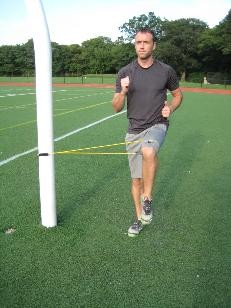
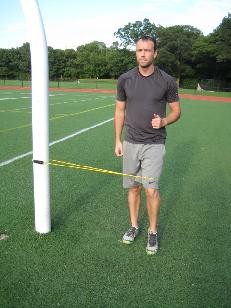
Value for runners: This exercise will improve your balance, foot strike and strengthen your abductors. This is especially useful for runners who suffer from excessive leg crossover.
Instructions: Focus on balance and keeping the leg attached to the theraband perpendicular to the ground (not tilting inwards). Advanced runners can stand on a balance board or close their eyes for added difficulty. Perform 15-25 repetitions each leg.
Side Plank
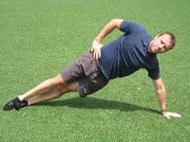
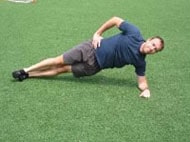

Muscle groups emphasized: transverse abdominus, gluteus medius and gluteus minimus muscles (abductors), the adductor muscles of the hip, and the external and internal obliques
Value for runners: The obliques, adductors, and abductors help stabilize the hips and prevent excessive twisting motion. The side plank will prevent injuries to the hip and the IT band and also correct possible hip drop problems.
Logistics: Hold the side plank position for up to 60 seconds.
Instructions: Like the front plank, do not let your hips bend towards the ground or point towards the air. There should be a straight line down from your head to your feet. Beginner runners can balance on their hands instead of their elbow (figure 1). Advanced runners can lift their top leg off the ground (figure 3)
These exercises will help get you started on building a stronger foundation, avoiding injury and improving performance.
If you need help developing and implementing a full strength training routine to decrease injury and improve performance, check out our strength training for runners program. Specific strength training prescriptions for every race distance from 5k to the marathon, 18 progressive routines, injury prevention and much more.


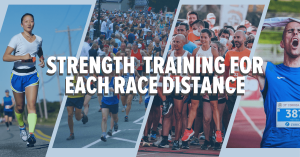
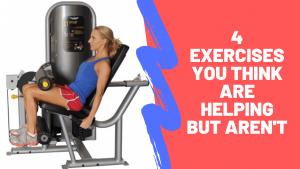

One Response
This is such a great and helpful article! I have been looking for something just like this. Time to incorporate these exercises into my routine! Looking forward to more posts from you.
Kathryn
ChicksDigRunning.com